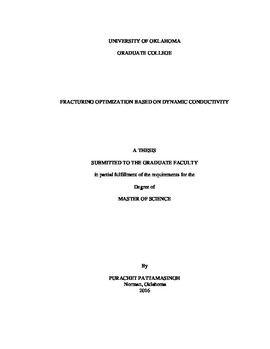| dc.description.abstract | This thesis presents a systematic approach to evaluate and optimize production performance of fractured wells in tight oil formations. Underperformed hydraulically fractured wells have been widely reported; poor design is often considered as the explanation; i.e. base line conductivity or Unified Fracture Design (UFD) is adopted without incorporating conductivity damaging parameters such as multiphase flow, non-Darcy flow, proppant embedment, fine migration and plugging, and proppant diagenesis. Therefore, we do not often observe the anticipated productivity in practice. This thesis is driven by the following hypothesis: “the predominant damaging parameters varies with fracture widths”. Moreover, reducing the cost of fracturing while maintaining the same productivity for fractured wells has become one of the main challenges of the industry.
The unfavorable effects of proppant embedment, inappropriate proppant placement, gelling damage, fines migration and pore blockage, and cyclic stress on well productivity are investigated. A sensitivity study is performed using experimental design to evaluate significance of the damaging parameters for a range of fracture widths. In addition, net present value (NPV) and profitability ratio (PIR) are used for economic evaluation of three types of proppants: sand, ceramic, resin coated sand (RCS). Finally, optimization of fracture design is performed using PIR approach.
The results indicate that the damaging parameters can decrease cumulative production by 73 % in the examples studied here. The proppant embedment and proppant placement are dominant damaging mechanisms for fractures with small width. However, gelling damage and cyclic stress are the most sensitive parameters for fractures with large width.
Overall, RCS proppants demonstrate better performance, NPV, and PIR over ceramic and sand proppants for all range of proppant concentration in the studied examples. Using PIR approach, an optimal fracture half length of 400 ft is achieved for low average proppant concentration of 0.17 lb/ft2 for RCS proppant. In addition, the PIR approach suggests an optimal fracturing scenario with 16% less initial cost compared to the NPV approach without significant reduction of the profit.
The outcome of this research will provide the field operators with remarkable knowledge on how to do a better fracturing design. | en_US |
